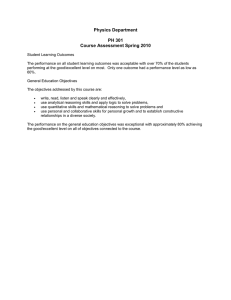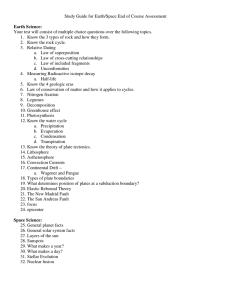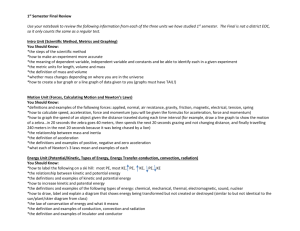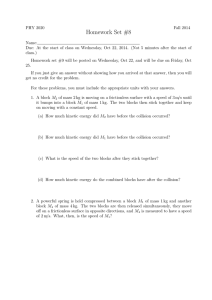FINAL EXAM, PHYSICS 1408, August 6, 2009, Dr. Charles W....
advertisement
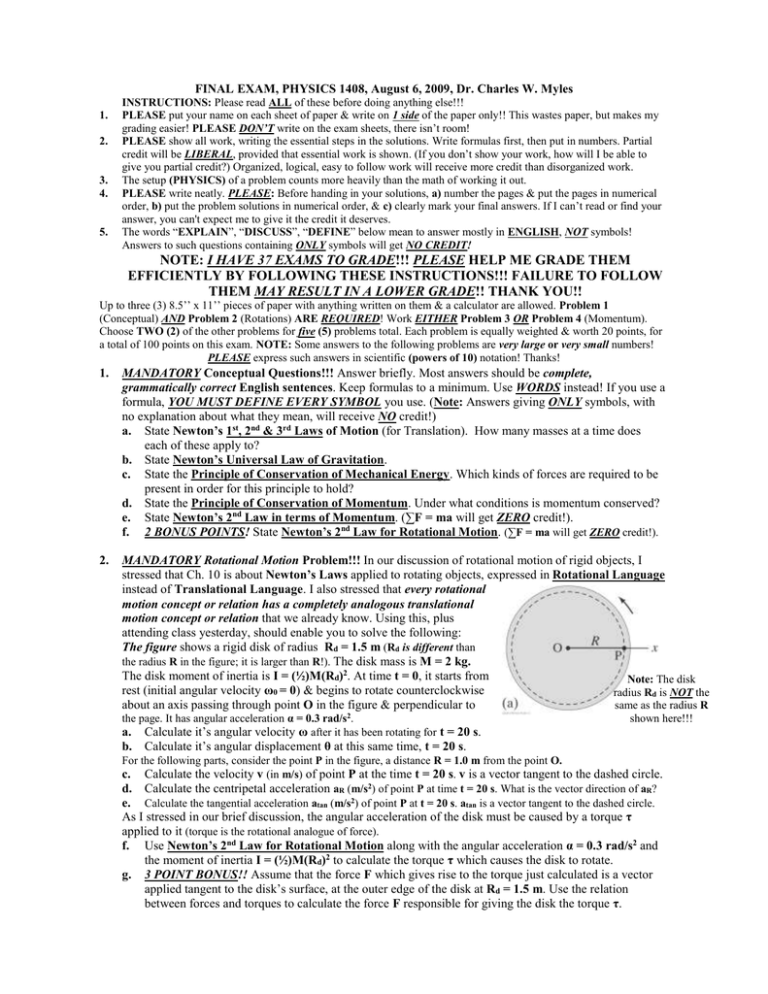
FINAL EXAM, PHYSICS 1408, August 6, 2009, Dr. Charles W. Myles 1. 2. 3. 4. 5. INSTRUCTIONS: Please read ALL of these before doing anything else!!! PLEASE put your name on each sheet of paper & write on 1 side of the paper only!! This wastes paper, but makes my grading easier! PLEASE DON’T write on the exam sheets, there isn’t room! PLEASE show all work, writing the essential steps in the solutions. Write formulas first, then put in numbers. Partial credit will be LIBERAL, provided that essential work is shown. (If you don’t show your work, how will I be able to give you partial credit?) Organized, logical, easy to follow work will receive more credit than disorganized work. The setup (PHYSICS) of a problem counts more heavily than the math of working it out. PLEASE write neatly. PLEASE: Before handing in your solutions, a) number the pages & put the pages in numerical order, b) put the problem solutions in numerical order, & c) clearly mark your final answers. If I can’t read or find your answer, you can't expect me to give it the credit it deserves. The words “EXPLAIN”, “DISCUSS”, “DEFINE” below mean to answer mostly in ENGLISH, NOT symbols! Answers to such questions containing ONLY symbols will get NO CREDIT! NOTE: I HAVE 37 EXAMS TO GRADE!!! PLEASE HELP ME GRADE THEM EFFICIENTLY BY FOLLOWING THESE INSTRUCTIONS!!! FAILURE TO FOLLOW THEM MAY RESULT IN A LOWER GRADE!! THANK YOU!! Up to three (3) 8.5’’ x 11’’ pieces of paper with anything written on them & a calculator are allowed. Problem 1 (Conceptual) AND Problem 2 (Rotations) ARE REQUIRED! Work EITHER Problem 3 OR Problem 4 (Momentum). Choose TWO (2) of the other problems for five (5) problems total. Each problem is equally weighted & worth 20 points, for a total of 100 points on this exam. NOTE: Some answers to the following problems are very large or very small numbers! PLEASE express such answers in scientific (powers of 10) notation! Thanks! 1. MANDATORY Conceptual Questions!!! Answer briefly. Most answers should be complete, grammatically correct English sentences. Keep formulas to a minimum. Use WORDS instead! If you use a formula, YOU MUST DEFINE EVERY SYMBOL you use. (Note: Answers giving ONLY symbols, with no explanation about what they mean, will receive NO credit!) a. State Newton’s 1st, 2nd & 3rd Laws of Motion (for Translation). How many masses at a time does each of these apply to? b. State Newton’s Universal Law of Gravitation. c. State the Principle of Conservation of Mechanical Energy. Which kinds of forces are required to be present in order for this principle to hold? d. State the Principle of Conservation of Momentum. Under what conditions is momentum conserved? e. State Newton’s 2nd Law in terms of Momentum. (∑F = ma will get ZERO credit!). f. 2 BONUS POINTS! State Newton’s 2nd Law for Rotational Motion. (∑F = ma will get ZERO credit!). 2. MANDATORY Rotational Motion Problem!!! In our discussion of rotational motion of rigid objects, I stressed that Ch. 10 is about Newton’s Laws applied to rotating objects, expressed in Rotational Language instead of Translational Language. I also stressed that every rotational motion concept or relation has a completely analogous translational motion concept or relation that we already know. Using this, plus attending class yesterday, should enable you to solve the following: The figure shows a rigid disk of radius Rd = 1.5 m (Rd is different than the radius R in the figure; it is larger than R!). The disk mass is M = 2 kg. The disk moment of inertia is I = (½)M(Rd)2. At time t = 0, it starts from Note: The disk rest (initial angular velocity ω0 = 0) & begins to rotate counterclockwise radius Rd is NOT the about an axis passing through point O in the figure & perpendicular to same as the radius R the page. It has angular acceleration α = 0.3 rad/s2. a. Calculate it’s angular velocity ω after it has been rotating for t = 20 s. b. shown here!!! Calculate it’s angular displacement θ at this same time, t = 20 s. For the following parts, consider the point P in the figure, a distance R = 1.0 m from the point O. c. Calculate the velocity v (in m/s) of point P at the time t = 20 s. v is a vector tangent to the dashed circle. d. Calculate the centripetal acceleration aR (m/s2) of point P at time t = 20 s. What is the vector direction of aR? e. Calculate the tangential acceleration atan (m/s2) of point P at t = 20 s. atan is a vector tangent to the dashed circle. As I stressed in our brief discussion, the angular acceleration of the disk must be caused by a torque τ applied to it (torque is the rotational analogue of force). f. Use Newton’s 2nd Law for Rotational Motion along with the angular acceleration α = 0.3 rad/s2 and the moment of inertia I = (½)M(Rd)2 to calculate the torque τ which causes the disk to rotate. g. 3 POINT BONUS!! Assume that the force F which gives rise to the torque just calculated is a vector applied tangent to the disk’s surface, at the outer edge of the disk at Rd = 1.5 m. Use the relation between forces and torques to calculate the force F responsible for giving the disk the torque τ. 3. NOTE: EITHER PROBLEM 3 OR PROBLEM 4 (Momentum) IS REQUIRED!!!!! See figures. A mass m1 = 9 kg, is on a horizontal, frictionless surface. In Fig. 1, it moves to the right at initial velocity v1 = 11 m/s. It collides with a mass m2 = 15 kg which is initially at rest. The collision is completely inelastic, so they stick together, as in Fig. 2 & move to the right with velocity v´. m1 = 9 kg v1 = 11 m/s Figure 1 Figure 2 stick together! v´ = ? m2 = 15 kg v2 = 0 a. Calculate the momentum & the kinetic energy of mass m1 before the collision. b. Calculate the momentum of the two stuck together masses & their velocity v2 after the collision. What Physical Principle did you use to find these? c. Calculate the impulse given to m2 by m1 due to this collision. Stated another way, calculate the change in momentum Δp2 of m2 due to the collision. d. If the collision time is Δt = 4.9 × 10-3 s, calculate the average collision force that m1 exerts on m2 in this collision. What Physical Principle did you use to calculate this? e. Calculate the kinetic energy of the stuck together masses in Fig. 2. Is kinetic energy conserved in this collision? Why or why not?? (Note: It is physically impossible for kinetic energy to INCREASE in a collision!) 4. NOTE: EITHER PROBLEM 3 (Momentum) OR PROBLEM 4 (Momentum) IS REQUIRED!!!!! See the figure. Two bumper cars in an amusement park have an elastic collision as one approaches the other from the rear. Their masses are m1 = 445 kg & m2 = 575 kg. The initial velocities are both in the same direction (Fig. a) & are (for m1) v1 = 4.9 m/s & (for m2) v2 = 3.8 m/s. After the collision, the velocities v1´ & v2´ are still in the same direction (Fig. b). a. Calculate the total momentum p1 + p2 & the total kinetic energy KE1 + KE2 of the two cars before the collision. b. Calculate the total momentum p1´+ p2´ & the total kinetic energy KE1´ + KE2´of the two cars after the collision. (Hint: You can do this using the results of part a, along with physical principles. You DON’T need to know the answers to part c before answering this!) What physical principles did you use to answer this? Is kinetic energy conserved in this collision? c. Calculate the velocities v1´ & v2´ of the cars after the collision. (Hint: To solve this you MUST solve two algebraic equations in two unknowns!) d. e. 5. Calculate the impulse that was delivered to m1 by m2. Stated another way, calculate the change in momentum Δp1 of m1 due to the collision. If the collision time was Δt = 3.9 10-3 s, calculate the average force exerted by m2 on m1. What physical principle did you use to do this calculation? NOTE: WORK TWO (2) OF PROBLEMS 5, 6, 7 or 8!!!!! See figure of a frictionless track that marbles can be rolled down. The circular loop near the middle has radius R = 0.39 m. The right end of the track rises to height y3 = 0.29 m. A marble! -- v0 = 0 marble, mass m = 0.16 kg, is put on v2 = ? the track and released from rest at | v3 = ? height H = 1.4 m. (Left of figure.) loop! | y3 = 0.29 m When it reaches the right end of the H = 1.4 m R = 0.39 m track, it’s velocity v3 is unknown. | h v = ? 1 (The large circle in the middle of the figure is the LOOP, not the marble!) a. b. c. | Calculate the potential energy of the marble at its starting point (on left of the track.). Calculate the kinetic energy & the velocity v1 of the marble when it has reached the bottom part of the track just before it starts onto the loop. Calculate the potential energy, the kinetic energy, & the velocity v3 of the marble when it has reached the right end of the track. (Hint: It doesn’t stop there, v3 ≠ 0, so obviously it flies off the track. However, CONTINUED ON NEXT PAGE!! that is not part of this problem! Note: Answers obtained by setting the kinetic energy equal to the potential energy at this point will receive ZERO credit! Especially at this stage of your physics learning, such answers show a serious lack of understanding of the Principle of Mechanical Energy Conservation!) d. e. 6. Calculate the potential energy, the kinetic energy, & the velocity v2 of the Marble when it has reached the top of the loop. (Hint: At that point, the height y = 2R!) What Physical Principle did you use to solve parts b, c, & d? NOTE: WORK TWO (2) OF PROBLEMS 5, 6, 7, or 8!!!!! See figure. Use energy methods to solve this!!! NO credit will be given for force methods! You don’t need force components or the incline angle θ to solve this! A block, mass m = 7 kg, is on a horizontal, frictionless surface. It is pressed against an ideal spring, of constant k = 820 N/m, & is initially at rest. (Left of figure at point A.) At point A, the spring is compressed a distance xA = 0.29 m from its equilibrium position. The block is released & it moves first to point B, which is at the bottom of a frictionless incline. (Middle of figure at point B.) It then moves up the incline & stops at point C, at height h above the original position. (Right of figure at point C.) yC = h = ? vC = 0 xA = 0.29 m yB = 0 vA = 0 vB = ? a. Calculate the elastic (spring) potential energy of the block at point A. b. Calculate kinetic energy the block at point B. What Physical Principle did you use to do this calculation? c. Calculate the speed vB of the block at point B. d. Calculate gravitational potential energy of the block at point C & the height h up the incline at which it stops. What Physical Principle did you use to do this calculation? e. Calculate the kinetic energy & the velocity of the block when it is at height y = 0.3 m above the horizontal surface. (Not shown. Above point B & below point C. Note: Answers obtained by setting the kinetic energy equal to the potential energy at this point will receive ZERO credit! at this stage of your physics learning, such answers show a serious lack of understanding of the Principle of Mechanical Energy Conservation!). 7. NOTE: WORK TWO (2) OF PROBLEMS 5, 6, 7, or 8!!!!! See figure. A helicopter, mass M = 1.6 104 kg, moves up with acceleration a = 1.3 m/s2. It is lifting an object of mass m = 3.2 103 kg, connected to it’s bottom by a massless cable. The upward force, FP, on the helicopter exerted by the air on the copter is unknown. So is the cable tension FT, which, of course, acts down on the copter & up on the object. (Hints: The motion is vertical, but the acceleration is obviously NOT g downward, but a upward! If it were g downward, the object would be in FP free fall & FT would be zero! Also, FT can’t possibly be = mg, or a would be zero!). a. Sketch the free body diagrams for the helicopter & the object, properly labeling all forces. Don’t forget the weights of the helicopter & the other mass, not shown in the figure! b. Apply Newton’s 2nd Law to the helicopter & the object to find the two equations needed to solve for FP & FT. Writing these without substituting in numbers, will receive more credit than writing them with numbers substituted in! Using the equations from part b, calculate FT & FP. If the helicopter is moving upward at velocity v0 = 8 m/s when the cable becomes tight & starts to lift the object, calculate the distance upward the helicopter & the other mass have traveled at time t = 8.0 s later. (Hint: Please note again that the c. d. acceleration is obviously NOT g downward, but a upward!) 8. NOTE: WORK TWO (2) OF PROBLEMS 5, 6, 7, or 8!!!!! See figure. A box of mass m = 25 kg is accelerated by being pushed across a flat table, using a force F = 45 N, which makes an angle θ = 30° with the horizontal. The coefficient of kinetic friction between the box & the surface is μk = 0.18. There is no vertical acceleration. a. Sketch the free body diagram for the box, properly labeling all forces. CONTINUED ON NEXT PAGE!! a FT FT b. c. d. e. 9. PROBLEM 8, part a CONTINUED!! Calculate the horizontal & the vertical components of the force F. Calculate the weight of the box and use Newton’s 2nd Law in the vertical direction to calculate the normal force FN between the box & the surface. (Note: Answers stating that FN is equal & oppositely directed to the weight will receive ZERO credit! Especially at this stage of your physics learning, such answers show a serious lack of understanding of vector forces & Newton’s 2nd Law!!!!) Calculate the friction force Ffr on the box as it moves to the right. Use Newton’s 2nd Law to find the acceleration a of the box. What forces cause this acceleration? Calculate the work done by the constant force F & the work done by the friction force Ffr as the box moves to the right through a horizontal displacement x = 15 m. BONUS QUESTIONS! (10 bonus points total!) Answer briefly, in a few complete, grammatically correct English sentences. You may supplement these sentences with equations, but keep these to a minimum and EXPLAIN what the symbols mean! I want most of the answer to be in WORDS! (Note: Answers with ONLY symbols, with no explanation about what they mean, will receive NO credit!) a. See figure. A hockey puck is sliding (to the right) at constant velocity across a flat, horizontal, frictionless ice surface. Which of the sketches in the figure is the correct free body diagram for this puck? WHY? Explain your answer using Newton’s Laws! (Hint: Is there a net force in the direction of the puck’s motion?) b. See figure. You are riding in a convertible with the top down. The car is moving to the right (x-direction) at constant velocity v0x. You throw a ball straight up (from your viewpoint) with an initial velocity v0y while the car travels forward at v0x. Neglect air resistance. Will the ball land behind the car, in front of the car, or in the car? WHY? Explain (briefly!) your answer. Use what you know about projectiles!. Make a sketch of the situation to illustrate your explanation. c. See figure. Paul & Kathleen start from rest (on the left) on two different shaped, frictionless water slides. They start at the SAME Both start at | vertical height h (Note: The figure shows them at different heights the same height! because it shows them AFTER they have started down!). Which rider is | moving at the fastest speed at the bottom? What Physical Principle h did you use to answer this? If they start at the same time, which | rider gets to the bottom first? Why ? (Answer in words!!) | Sometimes this session I briefly shared with you some interesting (to me!) facts (not in the book!) about Newton’s scientific achievements & also about his life & his dealings with fellow scientists. If you were in class when I talked about these things, you should be able to answer the following questions. For each, write a few complete sentences. d. Tell me about ONE of Newton’s scientific achievements OTHER THAN his development of his three Laws of Motion. BE SPECIFIC! e. Tell me about ONE of the facts I shared with you about Newton’s life & his dealings with fellow scientists. BE SPECIFIC!


